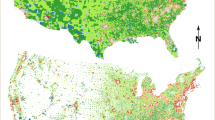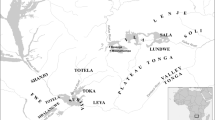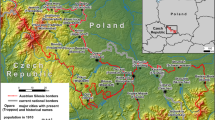Abstract
This article deals with using digitised maps inhistorical research and their possible contributionsto it. The use of cartographic data is especiallyuseful in research dealing with the spatialdistribution of various phenomena. The spatialdistribution of rural social strata is one suchphenomenon that has not yet received much attention.The case study of Pischelsdorf, an Austriansettlement, in the beginning of the nineteenth centuryshall serve as an example for such research.Pischelsdorf is situated in the Austrian province ofStyria, about 150 km from Vienna, and served as asmall centre for trade and handicraft for thesurrounding villages. This study is based on the landregister of 1822 which has been digitised.
Similar content being viewed by others
References
Allmer F. “Der Stabile Kataster in der Steiermark. Kurze Zusammenfassung für Archivbenützer.” Mitteilungen des steiermärkischen Landesarchivs, Folge 26. Ed. Dr. F. P. Graz (1976), 87–98.
Becker H. “Allgemeine Historische Agrargeographie (Teubner Studienbücher Geographie).” Stuttgart, 1998.
Born M. “Die Entwicklung der deutschen Agrarlandschaft.” Darmstadt, 1974.
Bresslau H.(†) and K, Paul, ed. “Die Urkunden Heinrichs III” Monumenta Germaniae Historica, Diplomata, 5. Berlin, 1931.
Bundesamt für Eich-und Vermessungswesen, ed. Behelf zur Fachprüfung für den höheren technischen Vermessungsdienst, Heft 1. Wien, 1949.
Christaller W. “Die zentralen Orte in Süddeutschland. Eine ökonomisch-geographische Untersuchung über die Gesetzmäßigkeit der Verbreitung und Entwicklung der Siedlungen mit städtischen Funktionen. Jena, 1933.
Denley P. “Models, Sources and Users: Historical Database Design in the 1990s. History and Computing, 6(1) (1994), 33–43.
Everett J. E. κλ∈ιω 5.1.1.: A source-oriented data processing system for historical documents. In: Computers and the Humanities 29 (1995), 307–316.
Faber T. F. Sozialgruppen als Träger der Allmendteilungen im Amt Kevelaer in der ersten Hälfte des 19. Jahrhunderts. Ed. J. Smets and T. F. Faber (1987) Kevelaer-Gesellschaft und Wirtschaft am Niederrhein im 19. Jahrhundert (Land und Leute zwischen Rhein und Maas. Veröffentlichungen zur Volkskunde und Kulturgeschichte, vol. 3, ed. Robert Plötz). Kevelaer (1987), 195–290.
Gaál Károly and Bockhorn Olaf, ed. Tadten. Eine dorfmonographische Forschung der Ethnographia Pannonica Austriaca 1972/73 (Wissenschaftliche Arbeiten aus dem Burgenland, Heft 56, Kulturwissenschaften, Heft 21, ed. Burgenländisches Landesmuseum in Eisenstadt). Eisenstadt, 1976.
Grees H. Ländliche Unterschichten und ländliche Siedlung in Ostschwaben (Tübinger Geographische Studien, Heft 58, Sonderband 8, Ed. Herbert W. et al.). Tübingen, 1975.
Grees H. Unterschichten mit Grundbesitz in ländlichen Siedlungen Mitteleuropas. In: Die ländliche Siedlung als Forschungsgegenstand der Geographie, Ed. G. Henkel Wege der Forschung, 616, Darmstadt. 1983, 193–223.
Gruber S. Pischelsdorf im Spiegel des Franziszeischen Katasters. Quellenkunde und Sozialtopographie. Master's thesis. Graz, 1994.
Hershberg T. “The Philadelphia Social History Research Project.” Historical Methods Newsletter, 9 (1976), 43–58.
Hershberg T. “Interdisciplinary Research at the Philadelphia Social History Project.” Analytic goals, data and data manipulation strategies for the study of the 19th century industrial city. In: The use of Historical Process-Produced Data. Eds. J. M. Clubb and E. K. Scheuch, Historisch-Sozialwissenschaftliche Forschungen, Stuttgart. 6 (1980) 84–111.
Jeggle Utz (1986) Kiebingen-eine Heimatgeschichte. Zum Prozeß der Zivilisation in einem schwäbischen Dorf (Untersuchungen des Ludwig-Uhland-Instituts der Universität Tübingen, vol. 44, ed. Hermann Bausinger et al.). Tübingen. 2nd edition, 1986.
Kaser K. and S. Karl Bäuerliches Leben in der Oststeiermark seit 1848, 2 vol. Wien, Köln, Graz, 1986, 1988.
Landesgesetz-und Verordnungsblatt für das Herzogtum Steiermark, Jahrgang 1909, No. 73.
Landesgesetzblatt für das Land Steiermark, Jahrgang 1951, No. 65.
Lantos T. 950 Jahre Pischelsdorf. 1043–1993. Eine Geschichte des Marktes Pischelsdorf und seiner Umgebung. Mit besonderer Berücksichtigung der Besitzgeschichte in der südlichen Kulmlandschaft. Pischelsdorf, 1993.
Lego K. Geschichte des Österreichischen Grundkatasters. Wien, 1968.
Monmonier M. “Mapping It Out: Expository Cartography for the Humanities and Social Sciences.” Chicago Guides to Writing, Editing, and Publishing, Chicago, London, 1993.
Nemitz Jürgen. Die historische Analyse städtischer Wohn-und Gewerbelagen: die Auswertung sozialtopographischer Quellen (Halbgraue Reihe zur Historischen Fachinformatik, vol. A3, ed. Manfred Thaller). St. Katharinen, 1989.
Posch F. Atlas zur Geschichte des steirischen Bauerntums (Veröffentlichungen des Steiermärkischen Landesarchives, vol. 8). Graz, 1976.
Riedl H. Gleisdorf. Ein Beitrag zur Sozialgeographie einer oststeirischen Kleinstadt (Arbeiten aus dem Geographischen Institut der Universität Graz, vol. 14, ed. Herbert Paschinger). Graz, 1971.
Riehl W. H. Culturstudien aus drei Jahrhunderten. Stuttgart, 1862.
Sandgruber R. (1978) Österreichische Agrarstatistik 1750–1918 (Part 2 of Wirtschafts-und Sozialstatistik Österreich-Ungarns. Ed. Alfred H. and H. Matis, Materialien zur Wirtschafts-und Sozialgeschichte, Wien, 2 (1978),
Schmutz C. Historisch Topographisches Lexicon von Steyermark, Vier Theile. Gratz, 1822.
Schürer K. and D. Herman, ed. The Use of Occupations in Historical Analysis (Halbgraue Reihe zur Historischen Fachinformatik, vol. A19, Ed. M. Thaller). St. Katharinen, 1993.
Schwarzinger K. (1983) 100 Jahre Führung des Grundkatasters. In: 1883–1983. 100 Jahre Führung des Katasters. Wien (1983), 14–47.
Sharpless J. and W. S. Bass, Jr. Urban History. In: American Behavioral Scientist XXI (1977), 221–244.
Southall H. and Oliver Ed. Drawing Maps with a Computer... or Without? History & Computing, 2(2) (1990), 146–154.
Steidl A. Visualizing Space: the Application of the κλ∈ιω Datatype “Situs” in the Context of the History of Universities. In: The Art of Communication. Proceedings of the VIII. International Conference of the Association for History & Computing, Graz, Austria, August 24–27, 1993, ed. Gerhard Jaritz, Ingo H. Kropaè, Peter Teibenbacher (Grazer Grundwissenschaftliche Forschungen). Graz. 1 (1995), 481–488.
Taylor H. The Use of Maps in the Study of the Black Ghetto-Formation Process: Cincinnati, 1802–1910. Historical Methods, 17(2) (1984), 44–58.
Thaller M. κλ∈ιω. A Database System (Halbgraue Reihe zur Historischen Fachinformatik, vol. B11, ed. Manfred Thaller). St. Katharinen, 1993.
Thaller M. What is “source oriented data processing”; what is a “historical computer science”? In: Historical Informatics: an Essential Tool for Historians? A Panel Convened by the Association for History and Computing at the nineteenth Anunual (sic!) Meeting of the Social Science History Association, Atlanta, Georgia, October 14th, 1994. Atlanta (1994), 30–43.
Vasold G. Das Itinerar Erzbischof Konrads IV: von Salzburg (1291–1312). Computergestützte Itinerarerstellung und Itineraranalyse (Schriftenreihe des Instituts für Geschichte, vol. 8). Graz, 1996.
Winnige N. Krise und Aufschwung einer frühneuzeitlichen Stadt: Göttingen 1648–1756 (Veröffentlichungen der Historischen Kommission für Niedersachsen und Bremen, vol. 34; Quellen und Untersuchungen zur Wirtschafts-und Sozialgeschichte Niedersachsens in der Neuzeit). Hannover, 19 (1996).
Woollard M. and D. Peter Source-Oriented Data Processing for Historians: a Tutorial for κλ∈ιω (Halbgraue Reihe zur Historischen Fachinformatik, vol. A23, ed. Manfred Thaller). St. Katharinen, 1993.
Author information
Authors and Affiliations
Rights and permissions
About this article
Cite this article
Gruber, S. Spatial Distribution of Rural Social Strata: UsingDigitised Maps in Historical Research. Computers and the Humanities 34, 359–375 (2000). https://doi.org/10.1023/A:1026591719273
Issue Date:
DOI: https://doi.org/10.1023/A:1026591719273




